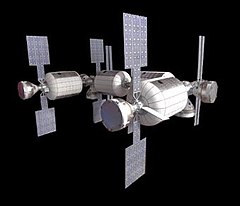Bigelow Commercial Space Station
| Station statistics | |
|---|---|
| Crew | 5–7 |
| Mass | 100,000 kg (220,000 lb) |
| Height | 30.0 m (98.4 ft) |
| Diameter | 6.7 m (22 ft) |
| Pressurised volume | 1,500 m3 (53,000 cu ft) |
 |
|
| Station statistics | |
|---|---|
| Crew | Up to 12 |
| Pressurised volume | 690 m3 (24,000 cu ft) |
 |
|
| Station statistics | |
|---|---|
| Crew | Up to 24 |
| Pressurised volume | 1,320 m3 (47,000 cu ft) |
The Bigelow Next-Generation Commercial Space Station is a private orbital space station currently under development by Bigelow Aerospace. The space station may be constructed of two B330 expandable spacecraft modules as well as a central docking node, propulsion, solar arrays, and attached crew capsules, though other possibilities like attaching a B330 to the International Space Station or flying a B330 alone have been suggested by Robert Bigelow.
On 8 April 2016, NASA launched a Bigelow inflatable module and attached it to the ISS, where it will be tested for two years. Any independent Bigelow Commercial space station will have to await the development of commercially available human rated orbital spacecraft. The first of these is expected to be the SpaceX Dragon 2 in 2017. Two B330 are expected to be ready by 2020 and a launch contract for one in 2020 has been signed.
Early work at Bigelow Aerospace on expandable space habitats, with plans to eventually assemble them into on-orbit space stations, began in the early years after the company was formed in 1999. By 2004, plans made public included assembly of multiple modules "into a manned space facility in low Earth orbit for both privately- and publicly-funded research and for space tourism."
Two more formal concepts have since been made public. By 2005, Bigelow space station plans had been further conceptualized into Commercial Space Station Skywalker, or CSS Skywalker. In mid-2010, Bigelow announced their Next-Generation Commercial Space Station—later named "Space Complex Alpha".
The initial dates for the Alpha complex were not achieved. In January 2013, the Alpha complex was specified to be an in-space assemblage of only two B330 modules, with the first module to be launched no earlier than 2016.
...
Wikipedia
